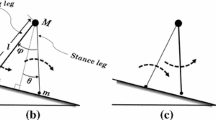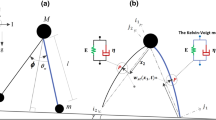Abstract
Asymmetric gait patterns may be observed in people with neurological or musculoskeletal disorders, in addition to healthy individuals. With reference to widely accepted research, leg length discrepancy and unequal leg mass are the main and direct causes of gait asymmetry, respectively. In previous studies, the independent influences of leg length discrepancy and unequal leg mass on gait patterns were investigated. However, the simultaneous effects of these factors on the gait patterns are unclear. It is therefore necessary to examine the effect of both factors on gait dynamics to determine the factors that cause more severe gait asymmetry. In this study, the effects of leg length discrepancy and unequal leg mass on gait patterns were investigated using a passive dynamic walking model. The findings revealed that gait asymmetry was more sensitive to leg length discrepancy than unequal leg mass by a factor of 60. As the rate of leg length and mass discrepancy changed, the output parameters characterizing the entire gait apparatus, such as step period, joint angular displacement, and joint angular speed, exhibited chaotic behaviors with bifurcations. Furthermore, when leg length discrepancy and unequal leg mass were simultaneously applied to the walking model, the effects of each factor on gait independently affect the gait patterns and gait patterns did not change in a new and unpredictable manner owing to nonlinearity. We expected that the asymmetric gait dynamics investigated in this study will contribute to the development of lower limb prosthetics and the gait training of patients with gait asymmetry.






Similar content being viewed by others
References
Mcgeer, T. (1990). Passive dynamic walking. I J Robotic Res., 9, 62–82.
Mochon, S., & McMahon, T. A. (1980). Ballistic walking. Journal of Biomechanics, 13(1), 49–57.
Collins, S.H., & Ruina, A. A bipedal walking robot with efficient and human-like gait. In Proceedings of the 2005 IEEE International Conference on Robotics and Automation (pp. 1983–8).
Lee, H. J., & Kim, J. Y. (2021). Balance control strategy of biped walking robot SUBO-1 based on force-position hybrid control. International Journal of Precision Engineering and Manufacturing, 22(1), 161–175.
Kim, J., Choi, C.-H., Spong, M. W. (2007). Passive dynamic walking with symmetric fixed flat feet. IEEE International Conference on Control and Automation (pp. 24–30).
Kuo, A. D. (2002). Energetics of actively powered locomotion using the simplest walking model. Journal of Biomechanical Engineering, 124(1), 113–120.
Kamamichi, N., Kaneda, Y., Yamakita, M., Asaka, K., & Luo, Z. W., Biped walking of passive dynamic walker with IPMC linear actuator. In SICE 2003 Annual Conference in Fukui (pp. 123–8) (2003).
Collins, S. H., Adamczyk, P. G., & Kuo, A. D. (2009). Dynamic arm swinging in human walking. Proceedings of the Biological Sciences, 276(1673), 3679–3688.
Chyou, T., Liddell, G. F., & Paulin, M. G. (2011). An upper-body can improve the stability and efficiency of passive dynamic walking. Journal of Theoretical Biology, 285(1), 126–135.
Handžić, I., & Reed, K. B. (2013). Validation of a passive dynamic walker model for human gait analysis. In Annu Int Conf IEEE Eng Med Biol Soc. (pp. 6945–8).
Moon, J.-S., & Spong, M. W. (2010). Bifurcations and chaos in passive walking of a compass-gait biped with asymmetries. In IEEE International Conference on Robotics and Automation (pp. 1721–6).
Moon, J.-S., & Spong, M. W. (2011). Classification of periodic and chaotic passive limit cycles for a compass-gait biped with gait asymmetries. Robotica, 29(7), 967–974.
Rasouli, F., Naraghi, M., Safa, A. T. (2016). Asymmetric gait analysis based on passive dynamic walking theory. In IEEE International Conference on Robotics and Mechatronics (ICROM) (pp. 361–6).
Honeycutt, C., Sushko, J., & Reed, K. B. (2011) Asymmetric passive dynamic walker. In IEEE International Conference on Rehabilitation Robotics 1–6.
Gritli, H., Khraeif, N., Belghith, S. (2011). Cyclic-fold bifurcation in passive bipedal walking of a compass-gait biped robot with leg length discrepancy. In IEEE International Conference on Mechatronics (pp. 851–6).
Gritli, H., Belghith, S., & Khraief, N. (2018). Complex walking behaviors, chaos and bifurcations of a simple passive compass-gait biped model suffering from leg length asymmetry. International Journal of Simulation and Process Modelling, 13(5), 446–462.
Walsh, M., Connolly, P., Jenkinson, A., & O’Brien, T. (2000). Leg length discrepancy–an experimental study of compensatory changes in three dimensions using gait analysis. Gait & Posture, 12(2), 156–161.
Khamis, S., & Carmeli, E. (2018). The effect of simulated leg length discrepancy on lower limb biomechanics during gait. Gait & Posture, 61, 73–80.
Gurney, B. (2002). Leg length discrepancy. Gait & Posture, 15(2), 195–206.
Khamis, S., & Carmeli, E. (2017). Relationship and significance of gait deviations associated with limb length discrepancy: A systematic review. Gait & Posture, 57, 115–123.
Woerman, A. L., & Binder-Macleod, S. A. (1984). Leg length discrepancy assessment: Accuracv and precision in five clinical methods of evaluation. Journal of Orthopaedic and Sports Physical Therapy, 5(5), 230–239.
Subotnick, S. I. (1981). Limb length discrepancies of the lower extremity (the short leg syndrome). Journal of Orthopaedic and Sports Physical Therapy, 3(1), 11–16.
Garcia, M., Chatterjee, A., Ruina, A., & Coleman, M. (1998). The simplest walking model: Stability, complexity, and scaling. Journal of Biomechanical Engineering, 120(2), 281–288.
Goswami, A., Thuilot, B., Espiau, B. Compass-like biped robot part I : Stability and bifurcation of passive gaits. INRIA (1996)
Iqbal, S., Zang, X., Zhu, Y., & Zhao, J. (2014). Bifurcations and chaos in passive dynamic walking: A review. Robotics and Autonomous Systems, 62(6), 889–909.
Muratagic, H., Ramakrishnan, T., & Reed, K. B. (2017). Combined effects of leg length discrepancy and the addition of distal mass on gait asymmetry. Gait & Posture, 58, 487–492.
Ramakrishnan, T., Lahiff, C.-A., & Reed, K. B. (2018). Comparing gait with multiple physical asymmetries using consolidated metrics. Frontiers in Neurorobotics, 12, 2.
Gregg, R. D., Degani, A., Dhaher, Y., & Lynch, K. M. (2011). The basic mechanics of bipedal walking lead to asymmetric behaviour. In IEEE International Conference on Rehabilitation Robotics (pp. 1–6).
Bhave, A., Paley, D., & Herzenberg, J. E. (1999). Improvement in gait parameters after lengthening for the treatment of limb-length discrepancy. Journal of Bone and Joint Surgery. American Volume, 81(4), 529–534.
Kaufman, K. R., Miller, L. S., & Sutherland, D. H. (1996). Gait asymmetry in patients with limb-length inequality. Journal of Pediatric Orthopedics, 16(2), 144–150.
Gong, Y., & Park, K. (2021). Bilateral gait asymmetry in patients with Hallux Valgus using normalized cross-correlation function. International Journal of Precision Engineering and Manufacturing, 22(2), 373–382.
Zhang, P., Tian, Y., Liu, Z., Yang, S., & Tian, R. (2008). Further research and comparison of gaits for compass-like biped and kneed passive dynamic walker. In Intelligent Robotics and Applications: First International Conference, ICIRA (pp. 1216–1226).
Chang, Y., Ko, C. Y., Jeong, B., Kang, J., Choi, H. J., Kim, G., Park, S., & Park, S. (2022). Changes in spatiotemporal parameters and lower limb coordination during prosthetic gait training in unilateral transfemoral amputees. International Journal of Precision Engineering and Manufacturing, 23(3), 361–373.
Author information
Authors and Affiliations
Corresponding author
Additional information
Publisher's Note
Springer Nature remains neutral with regard to jurisdictional claims in published maps and institutional affiliations.
Rights and permissions
Springer Nature or its licensor (e.g. a society or other partner) holds exclusive rights to this article under a publishing agreement with the author(s) or other rightsholder(s); author self-archiving of the accepted manuscript version of this article is solely governed by the terms of such publishing agreement and applicable law.
About this article
Cite this article
Lee, J., Park, K. Bifurcation and Chaotic Behaviors of a Passive Bipedal Walker with Leg Length Discrepancy and Unequal Leg Mass. Int. J. Precis. Eng. Manuf. 24, 2021–2031 (2023). https://doi.org/10.1007/s12541-023-00846-z
Received:
Revised:
Accepted:
Published:
Issue Date:
DOI: https://doi.org/10.1007/s12541-023-00846-z




